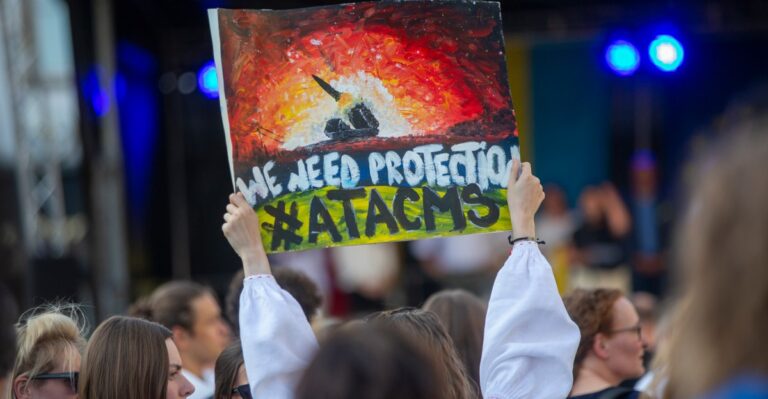Nearly three years after Russia's full-scale invasion of Ukraine, the Biden administration has authorized Ukraine to use long-range missiles supplied by the United States to attack Russia deeper.
The Ukrainian military quickly used that authorization and on Tuesday attacked an weapons depot about 110 miles from the Ukrainian border.
The United States and its NATO allies are hesitant to provide advanced weapons like the Army Tactical Missile System (ATACMS) used by Ukraine in that attack, fearing Russian retaliation or even nuclear escalation against NATO sites.
Fueling that fear, Russian President Vladimir Putin on Tuesday signed a new version of the country's nuclear doctrine that would theoretically make it easier for Russia to use nuclear weapons in the conflict. The new doctrine specifically authorizes nuclear attacks in response to attacks with conventional weapons, such as the long-range missiles that Ukraine currently authorizes, if those attacks involve the “participation or support of nuclear-armed states.” There is. The United States and other NATO countries.
Throughout the war, Russian leaders have threatened to use their nuclear weapons in a conflict if necessary. This has made Ukraine's allies cautious about the amount of aid they have provided so far, and has limited what the Ukrainian military can do with these weapons.
Ukraine's new ability to use long-range missiles to attack Russian territory and President Putin's confirmation of new nuclear rules have once again raised the question: Russia's war with Ukraine could escalate into a nuclear conflict Is it?
Throughout the war, experts downplayed Russia's desire for nuclear war. But the rapid escalation of the conflict in recent weeks, particularly Russia's new nuclear doctrine, may mean that possibility is closer than before.
How likely is it that Ukraine's new missile capabilities will lead to nuclear escalation?
Since Russia's invasion of Ukraine began, President Putin and other officials have said explicitly and obliquely that Russia could be forced to use nuclear weapons. Most experts agree that the risk of Russia using such weapons is low, but not negligible.
Under Russia's previous doctrine, which it updated on Tuesday, the country would only use nuclear weapons under four circumstances: the receipt of reliable data regarding ballistic missile attacks; nuclear or other weapons of mass destruction attack on Russia or its allies; Attack on Russia's nuclear infrastructure. Or an attack using conventional weapons that threatens the “very existence” of the Russian state. Under the new doctrine, Kremlin spokesman Dmitry Peskov suggested that an attack like Tuesday's in Ukraine could trigger a nuclear reaction.
But Samuel Sharup, a senior political scientist and distinguished chair of Russia and Eurasia policy at the Rand Corporation, told Box that the changes should not be taken as a response to the Ukraine strike.
The new doctrine “has been under consideration for a long time,” Sharup said. “The timing may have something to do with the decisive attack, but the content has been brewing for some time.”
President Putin and other officials do not appear to be making any major preparations to actually use nuclear weapons. But as the war continues, Putin and his officials' threats have become more explicit, including actually demonstrating nuclear capabilities. As recently as July, Russia and Belarus conducted joint military exercises to demonstrate Russia's tactical nuclear capabilities.
Initially, the United States and NATO reacted cautiously to the Russian threat, denying Ukrainian weapons or placing limits on their use. But over the past three years, with Putin's threat of nuclear war or war with NATO largely absent, the West has given Ukraine access to increasingly sophisticated weapons systems.
In addition to the risk of nuclear war, Ukraine's allies had to balance concerns that they might be drawn more directly into the conflict. Although Ukraine is not a member of the NATO military alliance, President Putin has previously warned that allowing long-range missiles (like those used on Tuesday) inside Russia would be considered a NATO attack on Russia. Ta.
U.S. officials who spoke to The Associated Press said they expected Russia's reaction, but that the Russian official's warnings were considered inflammatory rhetoric and would not trigger a change in U.S. behavior. . This suggests that the United States believes that Russia's use of nuclear capabilities is not too dangerous in the short term.
Russia has “never explicitly warned at the official level that it would use nuclear weapons in response to X, Y, and Z,” Sharap said. “The only clear red line they ever drew was regarding long range use. [or] Western weapons to attack Russia have now passed. So you can imagine that people expect a response that goes beyond just words. ”
1,000 days into the war, the conflict appears to be nearing a stalemate. There is no clear path to decisive victory for either side. Both sides are deploying new tactics to gain an advantage. Ukraine is equipped with long-range missiles. Recruits from Russia and North Korea. And now it appears that Russia and the United States are simply responding to each other's escalations. Russia sent North Korean troops into the field, the United States responded by authorizing the use of long-range missiles, and Russia lifted its new nuclear posture. Such actions are both reckless and dangerous, Charap said.
“You're in a spiral, which is the definition of a tit-for-tat dynamic, where your actions are driven not by your own goals but by countering the other person's actions,” Sharup said. . “It can only go in one direction, which is to keep raising the bar. The spiraling dynamic continues until someone gets out of control or someone tries to stop it.”


